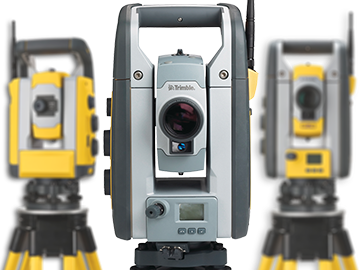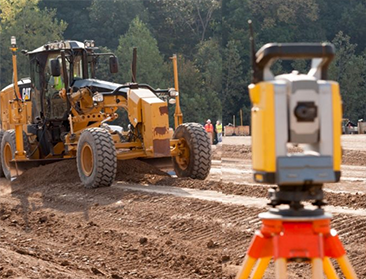
If you're in the market to purchase a Trimble robotic total station for construction survey and machine control, the choices can be confusing and overwhelming. We compare and highlight the differences between Trimble's SPS series instruments to help you make the best decision for your application and budget.
Trimble SPS Series Robotic Total Stations:
All of the S and SPS series instruments are built on the same platform as the original S6 survey instrument. The primary differences between SPS guns are:
- Accuracy
- Machine control capability (MC)
- Reflector-less measurement range (DR).
The SPS line is developed by Trimble's Heavy Civil & Engineering division and are therefore optimized to work with SCS900 and SiteWorks field software. Many - if not all of the SPS instruments are also compatible with Access 2017 and newer software.
Trimble SPS Robots For Machine Control:
SPS930 Universal Total Station:
 We start with the top-dog of the fleet, the SPS930 UTS. Dubbed "Universal Total Station" because it's capable of survey and machine control tasks. This is the instrument you'll need for precise layout and jobsites that require the most accurate grade control, like airport runways, bridges and 3D paving. The SPS930 and SPS730 are compatible with Trimble's GCS900, Earthworks and Caterpillar's Accugrade systems, as well a some GOMACO platforms.
We start with the top-dog of the fleet, the SPS930 UTS. Dubbed "Universal Total Station" because it's capable of survey and machine control tasks. This is the instrument you'll need for precise layout and jobsites that require the most accurate grade control, like airport runways, bridges and 3D paving. The SPS930 and SPS730 are compatible with Trimble's GCS900, Earthworks and Caterpillar's Accugrade systems, as well a some GOMACO platforms.
The SPS930 is a 1" accurate instrument - which is currently the most accurate instrument available in the SPS line (see comparison table below).
The original SPS930 was released around 2007 with DR300+ technology for reflector-less measurements. Since 2010 or so, DR300+ was replaced by DR Plus, which offers twice the reflector-less distance and faster DR measurement times. Other than that, the instrument has remained the same for 14 years.
SPS930 Highlights:
- Accuracy: . . . . . . 1"
- Machine Control capable *paid upgrade
- Works with SCS900 and Access ver 2017 and newer
- DR 300+ | DR Plus EDM technology - depending on age
SPS730 Universal Total Station:

The little brother of the SPS930, the SPS730 offers a machine control capable instrument with slightly less accuracy. Like the SPS930, DR Plus was upgraded from DR300 sometime in 2015. The accuracy of this instrument is stated separately for the horizontal and vertical axes.
SPS730 Highlights:
- Accuracy: . . . . . . . 3" horizontal / 2" vertical
- Machine Control capable *paid upgrade
- Works with SCS900 and Access ver 2017 and newer
- DR 300+ | DR Plus EDM technology - depending on age
SPS930 vs SPS730 Accuracy Comparison
The following 3D positioning accuracies provide an indication of total
system accuracy at commonly encountered ranges from the instrument
on a horizontal sighting. On steeper sightings, horizontal accuracy
increases and vertical accuracy decreases [1]
SPS930:
|
Distance Meters / Feet |
Position Accuracy Meters / Feet |
Height Accuracy Meters / Feet |
| 50 / 164 | 0.003 / 0.010 | 0.003 / 0.010 |
| 300 / 984 | 0.004 / 0.013 | 0.004 / 0.013 |
[1] Trimble SPS730 and SPS930 Universal Total Stations Datasheet, 2007
SPS730:
|
Distance Meters / Feet |
Position Accuracy Meters / Feet |
Height Accuracy Meters / Feet |
| 50 / 164 | 0.003 / 0.010 | 0.003 / 0.010 |
| 300 / 984 | 0.006 / 0.020 | 0.005 / 0.016 |
[1] Trimble SPS730 and SPS930 Universal Total Stations Datasheet, 2007
SPS630 Universal Total Station:
Similar to its bigger brothers, the SPS630 is capable of machine control, but at 5 arc seconds of angle accuracy it's the least accurate of the UTS line. The SPS630 is the youngest in the line, released around 2017, so DR Plus was standard.
SPS630 Highlights:
- Accuracy: . . . . . . . 5" horizontal / 5" vertical
- Machine Control capable *paid upgrade
- Works with SCS900 and Access ver 2017 and newer
- DR Plus EDM technology . . . . >1300 m (4265 ft) @ 90% reflective
Trimble SPS Robots for Survey & Stakeout:
While the SPSx30 instruments are machine control capable, the other SPS total stations are tailored for traditional survey tasks - without the machine control capability - so the selections are down to accuracy and reflector-less (DR) range.
Note: Trimble's S series instruments (S3, S5, S6, S7) may also be worth looking at, especially if you prefer using Access, Survey Pro or Carlson field software, as some of the SPS instruments have not been fully tested with survey-centric field software.
Trimble S series comparison >>
SPS720 and SPS620 Robotic Total Stations:
Built on that same MagDrive servo platform as the popular S6 and SPS930, the SPS720 and SPS620 were released around 2010. They include familiar standard features that simplify routine tasks like AutoLock, MutiTrack and SurePoint technology. DR Standard is featured on both instrument, so accuracy is the only difference.
SPS720 Highlights:
- Accuracy: . . . . . . . 3" horizontal / 2" vertical
- Works with SCS900 3.42 and newer / Access ver 2017 and newer
- DR Standard EDM technology. . . . > 800 m (2625 ft) @ 90% reflective
SPS620 Highlights:
- Accuracy: . . . . . . . 5" horizontal / 5" vertical
- Works with SCS900 3.42 and newer / Access ver 2017 and newer
- DR Standard EDM technology. . . . > 800 m (2625 ft) @ 90% reflective
SPS710 and SPS610 Total Stations:
A bit older than the SPS620 and SPS720, the SPS710 and SPS610 were released around 2007. Like all S series instruments, they are built on the MagDrive servo technology that made the S6 so reliable. Also like the S6, these instruments were offered in three variations: Servo, AutoLock and fully Robotic versions - with only the robotic option as a truly one-man instrument. These instruments were optimized to work with LM80 field software, but with current firmware, will also work with newer versions of SCS900. The most notable difference is the reduced DR distance of the SPS610. While it uses the same DR Standard EDM technology as the 710, the 610's DR range is tuned way down to only 150 meters vs 800 meters on the 710.
SPS710 Highlights:
- Accuracy: . . . . . . . 3" horizontal / 2" vertical
- Works with LM80, SCS900 3.42 and newer (Not tested with Access)
- DR Standard EDM technology. . . . > 800 m (2625 ft) @ 90% reflective
SPS610 Highlights:
- Accuracy: . . . . . . . 5" horizontal / 5" vertical
- Works with LM80, SCS900 3.42 and newer (Not tested with Access)
- DR Standard EDM technology. . . . > 150 m (492 ft) @ 90% reflective
SPS700 Total Station:
The SPS700 is the exact same instrument as the S6 (version 1). Originally released around 2007 with production stopping around 2010. It was the first instrument to be re-branded by Trimble specifically for their new construction division - which resulted from Trimble's purchase of Spectra Precision. Offered in Servo, AutoLock and Robotic configurations, the SPS700 was only offered in 5" accurate versions (horizontal).
SPS700 Highlights:
- Accuracy: . . . . . . . 5" horizontal / 2" vertical
- Works with LM80, SCS900 and Access 2017 and newer
- DR 300+ EDM technology. . . . > 800 m (2625 ft) @ 90% reflective
Trimble technology terms
Servo
Servo instruments are intended to function like a traditional total station, with some automation benefits. The biggest advantage over a traditional total station is when setting/staking out, the instrument calculates and automatically aims towards the calculated position of the selected point.
Additionally, the instrument will automatically point towards a selected reference target to check for instrument movement during measurements. Other than that, you do the rest.
In some cases, servo instruments can be upgraded to AutoLock, or even Robotic. Of course, the upgrade will cost more than buying a Robotic unit in the first place. These units operate best when using the TCU controller, as they are locked onboard the instrument - as opposed to fumbling around with a separate data collector.
AutoLock
Autolock enables the instrument to automatically lock on to and follow a prism. This means that the instrument is taking care of the pointing, and that position can be continuously updated as the target moves around the jobsite. Autolock is especially useful for site topo measurements. It is also useful when working in poor visibility and dark conditions.
Tasks such as measuring a round of angles can also be automated. Autolock eliminates the need to repetitively lock and unlock the horizontal and vertical axis, as well as target focusing. Bottom line – this feature saves time in the field.
Robotic
Robotic enabled instruments do not require anyone to physically position the instrument. Robotic total stations have built in drives that operate both horizontal and vertical axis and will automatically follow and track a prism. This enables single-user operation – as all tasks are performed at the rod with the data collector communicating to the instrument via wireless radio.
Trimble DR Technology
Direct Reflex (DR) EDM technology enables measurements to almost any type of surface. DR standard vs DR Plus vs DR300+ range differs depending on site conditions (dust, light, atmospheric conditions) and the color of the object you are measuring, i.e. dark objects reflect less light than lighter colored objects.
DR300+
Typical ranges in clear conditions:
Kodak Gray Card (18% reflective). . . . . . . >300 m (984 ft)
Kodak Gray Card (90% reflective). . . . . . . >800 m (2625 ft)
DR Standard**
Typical ranges in clear conditions. **Reduced in some instruments (S3 & SPS610)
Kodak Gray Card (18% reflective). . . . . . . >300 m (984 ft)
Kodak Gray Card (90% reflective). . . . . . . >800 m (2625 ft)
DR Plus
DR Plus was introduced in 2010 and is roughly twice the distance and offers faster measurements.
Kodak Gray Card (18% reflective). . . . . . . >600 m (1969 ft)
Kodak White Card (90% reflective). . . . . . . >1300 m (4265 ft)
DR HP
HP stands for "High Precision" which offers increased accuracy but at the expense of distance (1300 meters DR Plus vs only 150 meters for HP).
SurePoint
Ensures accurate pointing and measurements by actively correcting for unwanted movements like wind, handling, and sinkage.
FineLock
Uses a narrower field of view to detect targets without interference from surrounding prisms.
Long-Range FineLock
Extends distance measurements (to prisms) to 2500 m with 1 cm accuracy.
Automatic Servo Focus
Sets the optical focus for quick manual aiming when monitoring points in DR mode – with Trimble Access
VISION
VISION technology gives surveyors the ability to remotely see, capture and measure with live video feed from the instrument. Surveyors can see everything the instrument sees without a trip back to the tripod, but it's real value is utilizing the photographic data in Trimble Business Center, which overlays survey data on
the captured panoramic still images, enabling the surveyor to efficiently document
features that were surveyed.
Final Thoughts:
The primary difference between any Trimble SPS instrument is it's accuracy, reflectorless range and machine control capability. If you require an instrument that is machine control capable, look for the SPSx30 series, like the SPS730 or SPS930. Otherwise all SPS iterations are excellent performers and can last a lifetime when cared for. Always check Trimble's release notes for firmware and software compatibility, especially if you plan on using Access or Survey Pro software.
Please use this information as a guide to help you make your decision. Some features and functions listed as “standard” or “optional” may change over time.
Datasheets for all instruments are available on our Product Support page >>
